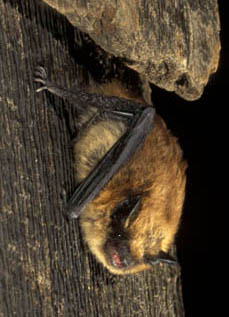
Description:
-
Recognition
-
Weight: 0.1 - 0.2 oz. (3-5 g)
-
Body length: 2 7/8 -3 1/4 in. (73-82 mm)
-
Wingspan: 8-10 in. (21-25 cm)
-
Forearm: 1 1/4 - 1 3/8 in. (31-34 mm)
The eastern small-footed bat is one of the smallest bats in Maryland. They can get just over 3 inches in length. Eastern small-footed bats are mostly golden brown in color and have a black facial mask, tragus, and ears. They look similar to little brown bats, but they have smaller feet that measure less than 0.3 inches in length.
Often, this species flies slow and erratically from 3- 10 feet off the ground. Eastern small-footed bats have been documented to live 12 years or more.
Roosts:
-
Summer Roost: Eastern small-footed bats spend summer days roosting in rock crevices, under boulders, in quarries, and very rarely in buildings.
-
Winter Roost: In the winter, big brown bats roost in caves and mines.
Diet:
Flies, mosquitoes, true bugs, beetles, ants, and other insects
Similar Species:
Little Brown Bat is much larger with larger feet.
Conservation:
Eastern small-footed bats has been historically rare throughout the eastern United States. In addition, they have dramatically declined in Maryland due to
white-nose syndrome. Eastern small-footed bats are listed as
species of greatest conservation need in Maryland. In addition, they are ranked as endangered and
highly state rare (S1).
Photo by: Dr. J. Scott Altenbach.
Return to Field Guide to Maryland Bats